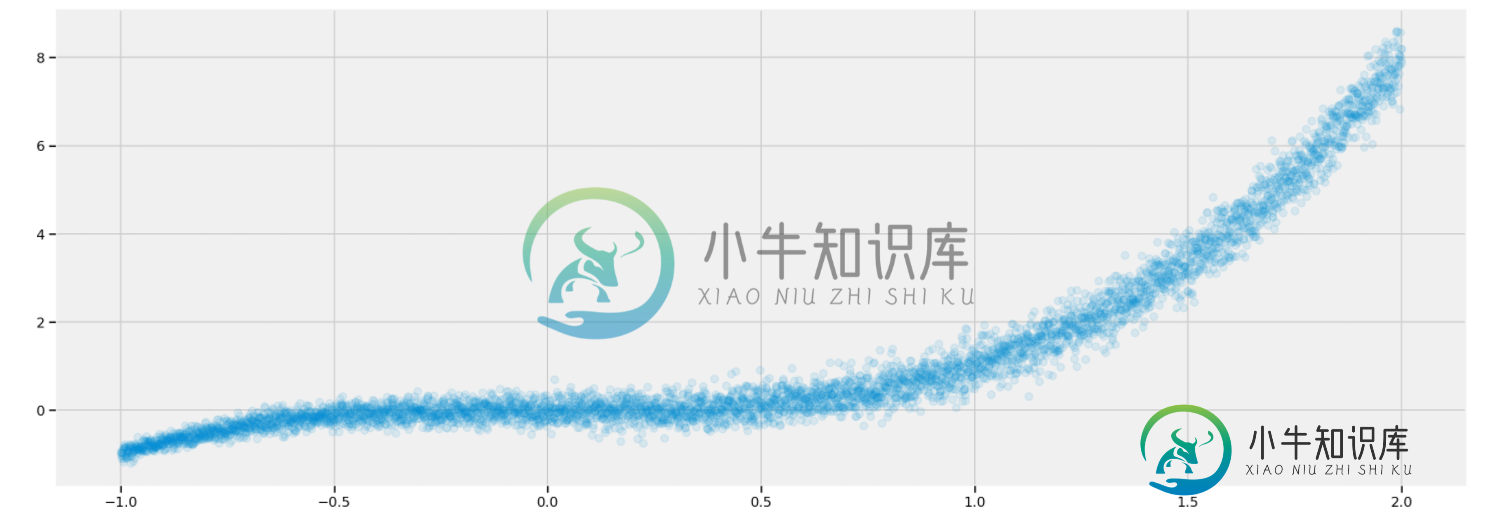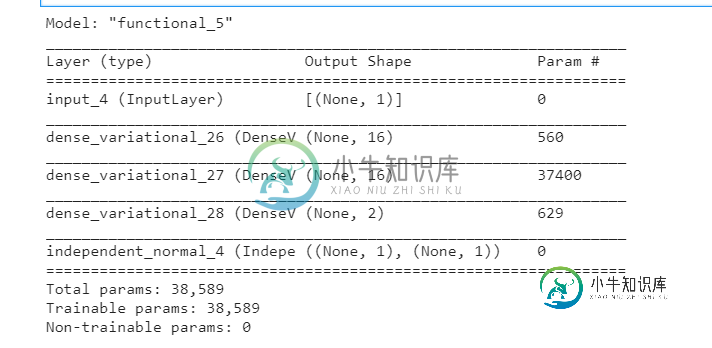在张力流概率中具有 3 个隐藏密集层的回归模型在训练期间返回 nan 作为损失
我开始熟悉张量流概率,在这里我遇到了一个问题。在训练期间,模型返回nan作为损失(可能意味着导致溢出的巨大损失)。由于合成数据的函数形式并不过分复杂,并且数据点与参数的比率乍一看并不可怕,至少我想知道问题出在哪里,以及如何纠正它。
代码如下 --附有一些可能有用的图像:
# Create and plot 5000 data points
x_train = np.linspace(-1, 2, 5000)[:, np.newaxis]
y_train = np.power(x_train, 3) + 0.1*(2+x_train)*np.random.randn(5000)[:, np.newaxis]
plt.scatter(x_train, y_train, alpha=0.1)
plt.show()

# Define the prior weight distribution -- all N(0, 1) -- and not trainable
def prior(kernel_size, bias_size, dtype = None):
n = kernel_size + bias_size
prior_model = Sequential([
tfpl.DistributionLambda(
lambda t: tfd.MultivariateNormalDiag(loc = tf.zeros(n) , scale_diag = tf.ones(n)
))
])
return(prior_model)
# Define variational posterior weight distribution -- multivariate Gaussian
def posterior(kernel_size, bias_size, dtype = None):
n = kernel_size + bias_size
posterior_model = Sequential([
tfpl.VariableLayer(tfpl.MultivariateNormalTriL.params_size(n) , dtype = dtype), # The parameters of the model are declared Variables that are trainable
tfpl.MultivariateNormalTriL(n) # The posterior function will return to the Variational layer that will call it a MultivariateNormalTril object that will have as many dimensions
# as the parameters of the Variational Dense Layer. That means that each parameter will be generated by a distinct Normal Gaussian shifted and scaled
# by a mu and sigma learned from the data, independently of all the other weights. The output of this Variablelayer will become the input to the
# MultivariateNormalTriL object.
# The shape of the VariableLayer object will be defined by the number of paramaters needed to create the MultivariateNormalTriL object given
# that it will live in a Space of n dimensions (event_size = n). This number is returned by the tfpl.MultivariateNormalTriL.params_size(n)
])
return(posterior_model)
x_in = Input(shape = (1,))
x = tfpl.DenseVariational(units= 2**4,
make_prior_fn=prior,
make_posterior_fn=posterior,
kl_weight=1/x_train.shape[0],
activation='relu')(x_in)
x = tfpl.DenseVariational(units= 2**4,
make_prior_fn=prior,
make_posterior_fn=posterior,
kl_weight=1/x_train.shape[0],
activation='relu')(x)
x = tfpl.DenseVariational(units=tfpl.IndependentNormal.params_size(1),
make_prior_fn=prior,
make_posterior_fn=posterior,
kl_weight=1/x_train.shape[0])(x)
y_out = tfpl.IndependentNormal(1)(x)
model = Model(inputs = x_in, outputs = y_out)
def nll(y_true, y_pred):
return -y_pred.log_prob(y_true)
model.compile(loss=nll, optimizer= 'Adam')
model.summary()

history = model.fit(x_train1, y_train1, epochs=500)

共有2个答案
该模型有38,589个可训练参数,但您只有5,000个点作为数据;因此,在如此多的参数下,有效的训练是不可能的。
问题似乎出在损失函数中:没有任何指定位置和尺度的独立正态分布的负对数似然导致未驯服的方差,从而导致最终损失值的爆炸。由于您正在试验变分层,因此您必须对认识不确定性的估计感兴趣,为此,我建议应用常数方差。
我试图在以下几行代码中对您的代码进行一些细微的更改:
> < li>
首先,最终输出y_out直接来自最终变分层,没有任何独立正态分布层:
y_out = tfpl.DenseVariational(units=1,
make_prior_fn=prior,
make_posterior_fn=posterior,
kl_weight=1/x_train.shape[0])(x)
其次,损失函数现在包含所需的正态分布的必要计算,但带有静态方差,以避免在训练期间损失放大:
def nll(y_true, y_pred):
dist = tfp.distributions.Normal(loc=y_pred, scale=1.0)
return tf.reduce_sum(-dist.log_prob(y_true))
然后,以与之前相同的方式编译和训练模型:
model.compile(loss=nll, optimizer= 'Adam')
history = model.fit(x_train, y_train, epochs=3000)
最后,让我们从训练的模型中抽取 100 个不同的预测,并绘制这些值以可视化模型的认识不确定性:
predicted = [model(x_train) for _ in range(100)]
for i, res in enumerate(predicted):
plt.plot(x_train, res , alpha=0.1)
plt.scatter(x_train, y_train, alpha=0.1)
plt.show()
经过3000个周期后,结果如下所示(为了加快训练速度,训练点数从5000点减少到3000点):
-
问题内容: 我有一个“一键编码”(全1和全0)的数据矩阵,具有260,000行和35列。我正在使用Keras训练简单的神经网络来预测连续变量。组成网络的代码如下: 但是,在训练过程中,我看到损失下降得很好,但是在第二个时期的中间,它就变成了nan: 我尝试使用代替,尝试替代,尝试使用和不使用辍学,但都无济于事。我尝试使用较小的模型,即仅具有一个隐藏层,并且存在相同的问题(在不同的点它变得很困难)。
-
这是尝试使用Tensforflow概率,更具体地说是DenseVariational层,但由于某种原因失败了。我如何更正代码?
-
我无法让贝叶斯线性回归与Tensorflow概率一起使用。这是我的代码: 有什么想法吗?
-
在keras中。应用程序中,有一个VGG16模型在imagenet上预先培训过。 该模型具有以下结构。 我想用密集层(fc1、fc2和预测)之间的缺失层微调此模型,同时保持模型的所有预训练权重不变。我知道可以使用
-
我正在讨论设计我们的API(Stream vs Collection作为返回类型)的最佳方式。这篇文章中的讨论非常有价值。 @BrainGotez的答案提到了一个条件,即集合优于流。我不太明白这意味着什么,谁能帮我举个解释的例子? 当有很强的一致性要求时,您必须生成移动目标的一致快照 我的问题是,具体而言,“强一致性要求”和“移动目标的一致快照”在现实应用中意味着什么?
-
我有这个代码,用于使用tenorflow hub的预训练通用编码器构建语义搜索引擎。我无法转换为tlite。我已将模型保存到我的目录中。 导入模型: 根据数据训练模型: 保存模型: 保存工作正常,但当我转换到tflite它给出错误。 转换码: 错误:

